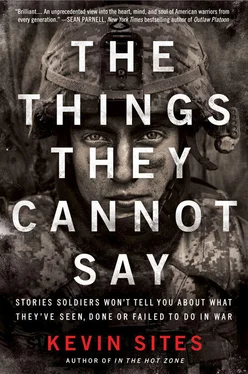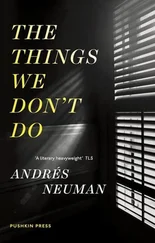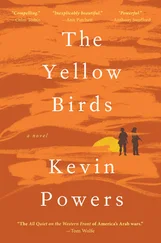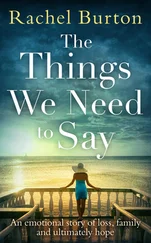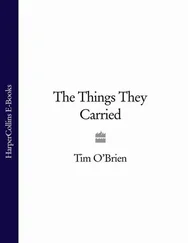“I saw their color and the bugs…,” he says, “and then I threw up. That kind of thing stays with you. But that was the job—we had to get a body count. And here were two more for the record.”
Caley had been drafted, pulled out of a life that could be defined as normal. He had married his high school sweetheart, was a shoe salesman during the day and took a few classes at Kent State University at night. The problem was that Caley didn’t take enough classes. You had to carry twelve credit hours to be considered a full-time student; otherwise you were eligible for the draft. Caley didn’t qualify for the student deferment that so many others had used to stay out of the war.
He had gotten married in February and by March he was in the Army.
“It was kind of a shock. I had no intention of being a soldier whatsoever,” he tells me during a late-night phone conversation. “But I knew when I was drafted—I believed I knew I was going to Vietnam. If you enlisted you got a choice of what you wanted to do. If you were drafted you were going to Vietnam. At that time, the war and death was the furthest thing from my mind. We were just kids, doing what kids do. Going out partying, etc.”
After his basic training at Fort Knox in Kentucky and his advanced infantry training (AIT) at Fort Polk in Louisiana, Caley thought he could put off Vietnam a little longer by volunteering for noncommissioned officer school at Fort Benning in Georgia. But it didn’t take long for him to realize this was not a good fit.
“I didn’t want to tell people to kill other people. That was an NCO’s job. I wanted out, and they put me in Casual Company,” he says.
Casual Company was the place the Army put people they didn’t know what to do with. It was a holding tank for guys who didn’t fit in, whom they considered misfits.
But Caley was presented with an opportunity while in Casual Company and his choice led him directly to the place he had been hoping to avoid.
“They asked if I wanted to walk dogs and I said yes. I didn’t realize I’d be walking dogs on point in combat.” Caley pauses. “But at least I did have some control.”
Or so he thought. Caley’s job was to be part of the 25th Infantry Division’s Platoon Scout Dogs, soldiers who would handle specially trained German shepherds and walk in advance of other ground troops, an early-warning system, literally sniffing out danger, bombs, booby traps and enemy fighters. In an infantry unit, walking point, being at the tip of an advancing squad, team or platoon, was considered the most dangerous and often lethal spot in the formation. As part of the Scout Dogs, Caley and his fifty-seven-pound shepherd named Baron walked in front of the man on point. Caley learned quickly that if he was going to survive his deployment he would have to learn to trust Baron.
“One time I was telling the dog to search and move and he wouldn’t move.” Caley tried to nudge him forward, but Baron stayed put. “It just so happens about three or four feet in front of us was a trip wire, a booby trap.” Baron had saved his life. “All your faith is put in the animal,” Caley says. “When we were walking point we never really lost anyone. I take pride in that.”
How Caley and the other dog handlers operated was a simple but dangerous protocol: if the dog alerted him and he saw movement, Caley would raise his M16 and fire. Doing that, however, would usually prompt the rest of the unit to do the same. But being so far out front, Caley and his dog could sometimes end up in the crossfire.
Like anyone going into combat, nerves sometimes got the best of him. The first time Caley actually did fire his rifle in combat, the target was nothing more than a pile of leaves. Caley laughed at himself, explaining how Baron might alert him to something and “the next thing you know you’re opening up on trees and leaves and there’s nothing there.”
Caley grew into the job but never forgot the life he had been yanked from and wondered when he might be allowed to return. His helmet liner became a virtual calendar for his yearlong deployment. On it he had an outline of his home state of Ohio and a pattern of 365 squares—each representing a day. He would mark off every passing day with an “X” until his tour was over and he could go home. While he felt his job was important, Caley, like the other dog handlers, never felt like he belonged to any specific outfit. Since there were only around fifteen dog teams for the whole division, they were constantly shuffled out to different platoons in the field, specialists who were needed and requested the same way you might request a “tunnel rat” or the EOD team (Explosive Ordnance Disposal/bomb squad). [20] “Tunnel rat” was the nickname for American, Australian and New Zealand troops whose job it was to find and destroy the tunnel systems of Vietcong guerrillas in Vietnam. Once found, they would also have to penetrate them armed with nothing more than a flashlight in one hand and a .45 caliber pistol the other. They were often shorter men so that they could squeeze into the tunnels.
These experts were valued by the units they worked with but never really became a part of them. In the American military, they were nomadic loners, helping to protect and save lives but never really reaping the psychological rewards in terms of band-of-brother-type friendships and unit identity. It became even tougher to deal with when things went wrong.
On one patrol, he and Baron were leading an infantry unit about twenty-five feet off the trail (standard practice since the trails were often mined or booby-trapped) when Baron alerted him to something ahead moving down the trail. From where he was standing, Caley could see the figure wore a white shirt and black pants, but that was all he could make out. He and another soldier raised their M16s and fired. The figure slumped to the ground. Caley and Baron fell back with the rest of the main element while a squad moved up to check it out. When the squad returned they told Caley who had been in his crosshairs. He had killed an old man, a rice bearer. A legitimate target, they figured, since he was probably bringing food for “Charlie.” [21] American troops’ nickname for Vietnamese National Liberation Front guerrillas, or Vietcong (VC). In the NATO Phonetic Alphabet (used by the American military for radio communications), the word “Victor” is used for “V” and the word “Charlie” is used for “C,” so the “VC” for “Vietcong” became “Victor Charlie,” often shortened to just “Charlie.”
They shook their heads when Caley asked if he was armed. Regardless, he was part of the enemy body count now.
Caley recalls “not thinking about it that much at the moment.” There was a job to do and this was just another day, albeit not a very good one. Later, once his tour was over, the rice bearer would return. In describing his postwar state of mind to me Caley stops using the personal pronoun “I” and replaces it with “you,” attempting to find distance from the incident even with his language.
“That has an impact on you,” he says. “You’re human, you’re not brought up to do that. That’s not what you do. I’m having a tough time with this. It got much worse for me later on. You have a decision and whatever decision you make you’re going to have to live with the rest of your life. That was just spur-of-the-moment, you were trained to do that. But after you do it, you have time to think about it and you think about it over and over again. Every decision you make out there, you have to live with the consequences.”
He pauses, remembering the deeply polarized society he returned to after his deployment. It was just two months before the May 4, 1970, incident at Kent State University in his home state of Ohio, when National Guard troops fired sixty-seven rounds in thirteen seconds into a crowd of antiwar protesters, killing four and wounding nine. The environment did not engender rational debate but rather passionate and unyielding positions that often ended, like at Kent State, in the very violence the protesters were assailing. “How do you think it would be if I had tried to tell that story [about the rice bearer] when I got home?” Caley says. “How do you think it would’ve been received at that time?”
Читать дальше
